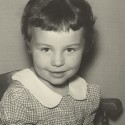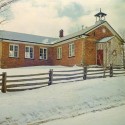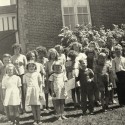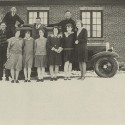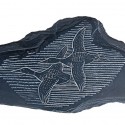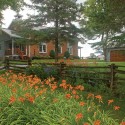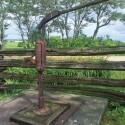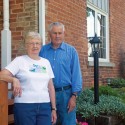Home and School
The sound of children’s laughter still echoes up the hillside at SS#1 Stanton, attended by four generations of the writer’s family, including the school’s current occupants who have made it their home.
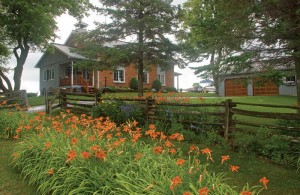
Orange day lilies bloom as they always have outside SS#1 Stanton, now a private home. Photo by Rosemary Hasner / Black Dog Creative Arts.
For exactly one hundred years, a couple of sharp tugs on the bell rope tolled the start of the school day at SS#1 Stanton in Mulmur Township.
The old bell still rings occasionally, but only when Bill Knisley climbs into the attic to sound it for the amusement of his grandchildren.
Like many of the seventeen schools that would eventually dot the township, Stanton school has found new life as a private residence. But from the outside, there is no mistaking what it was.
The bell tower – rebuilt in the original style – is a dead giveaway. All the windows are in the same position as the originals, but most are slightly larger and the sashes are lower. And the school’s original identifying plaque can still be seen above the sun porch, the only structural addition Bill and his wife Irene made to the building.
The Stanton area, the first part of Mulmur to be settled in the early 1830s, had the township’s first school. Three schools preceded the one in which Knisleys now live. It’s not known when the first two were built, but Mulmur: The Story of a Township (1951) indicates they were south of Stanton, now a hamlet but once a thriving village located one sideroad north of Highway 89 on Airport Road. The third school, built about 1852, was on the sideroad east of the village, on the north side. The final school was built in 1868 on a rise on the south side of Five Sideroad, a stone’s throw from its predecessor and about a quarter-mile east of Stanton.
Knisleys bought the school in 1968, the year it closed, and Irene – my first cousin – has more than a homeowner’s acquaintance with it. We are members of the fourth generation of our family who attended Stanton schools.
Our great-grandfather, Thomas Campaigne, would have been of school age in the 1850s and likely went to the third incarnation of the school. Our grandmother, Maude (Campaigne) Greer, was educated in the 1880s in the building in which Irene now lives. Irene’s mother, Viola (Greer) Armstrong, started the same school in 1915 and my father, Emerson Greer (Viola’s brother), began in 1928. Irene was at Stanton in the 1940s and I was there in the 1950s.
Bill, an elementary teacher, had his own local ties. Originally from the Durham area, his first teaching job, in 1953, was just up the road at the one-room school north of Mansfield.
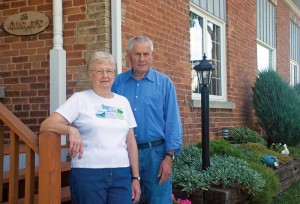
Irene Knisley attended the school that is now her home in the 1940s. Bill Knisley taught at a one-room school just north of nearby Mansfield. Photo by Rosemary Hasner / Black Dog Creative Arts.
By 1968, they were living in Toronto and looking for a property in the Mansfield area to use as a summer home for themselves and their three children. It was not sentimentality that prompted them to buy the school. “I told Bill, ‘Forget it, I’m not interested,’” Irene says.
But he could see potential in the old school with its sloping, treed lot and pastoral views, including a fifteen-mile panorama to the east. They paid less than $3,000, though at least one friend thought the school should be bulldozed. Indeed, not much had changed since Grandma Greer had been a pupil there eighty years before.
···
Life in a one-room, eight-grade school was light-years away from the experience of children today or even those who attended town schools at the time. Stanton school, for example, never had running water. In the beginning, pupils carried water across the sideroad from the village hotel. Later, a well was dug at the bottom of the schoolyard and buckets were carried up the hill. That’s what Knisleys had to do for a while, too, and the old pump is still there, although they dug a new well nearby.
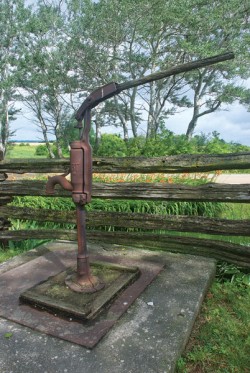
Stanton students originally carried water from the village hotel. After a well was dug, they had only to carry it up the hill – as did the Knisleys when they purchased the school in 1968. Today the pump is a lawn ornament with history.
Drinking water came from a bucket using a communal dipper and, until 1959, when two chemical toilets were installed indoors, the only bathroom was an outhouse.
An oil-burning stove heated the school for the last few years, but for ninety-plus years before that, the school’s “central” heating was a big, wood-burning box stove in the middle of the schoolroom. Every school day in cold weather, a local resident would fire up the stove about 7 a.m. so there would be heat when the teacher and pupils arrived.
In winter, after a long walk to school – two miles or more for some pupils – and after lunch and recesses, the school would be awash in the smell of wet wool as mitts, scarves and hats were spread out to dry on the large tin base of the stove. In later years, cans of food were set on top of the stove to warm for lunch.
For most of its life, Stanton school had one teacher and eight grades in one room. But for a time, that wasn’t the case. By the 1880s, the district was filling with settlers and the school was so crowded that an addition was built at a right angle on the back east side of the school. A second teacher was hired and for several years as many as 100 pupils attended the school daily.
In 1892, a school was built west of Rosemont to serve the extreme southeast of Mulmur and north end of Mono Township. The second room at Stanton was closed and was never used as a classroom again. It became a storage room and winter playroom, and would be known by all future generations at Stanton as “the back part.”
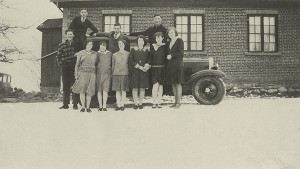
The senior class poses with the teacher’s car beside SS#1 Stanton. In the front row left is Luella (Greer) Murphy, aunt of the school’s current owner, Irene Knisley, and beside her is another cousin, Hazel (Greer) Moffat. Photo courtesy of Raymond Greer.
Throughout the years, baseball was the favourite game at Stanton, even though the slope of the schoolyard made it a less-than-ideal playing field: Second base was halfway up the hill. But from the youngest to the oldest, all the kids took part.
Irene Knisley remembers one teacher, a local woman named Edna Greer (no relation), who loved baseball and occasionally played with her pupils. One day, Irene says, the teacher was batting and lifted a ball all the way up the hill, breaking a school window.
What the schoolyard lacked as a softball diamond, it made up for in winter. Pupils would create an icy path down the hill and slide on blocks of wood. Sometimes we’d get permission to take our sleds and toboggans to a longer hill in a field across the road.
For decades, the highlight of the school year was the Christmas concert. A neighbour would bring a pine tree from the bush and the children would decorate it, along with the blackboards and walls, with homemade garlands, ornaments, streamers and drawings. People from all around would arrive on the appointed night to watch pupils perform the songs, recitations and skits they had been practising for weeks.
With eight grades, perhaps the teacher’s biggest challenge was to keep twenty-five to thirty pupils all occupied at once. At any one time, the grade 1 pupils might be printing the alphabet, grade 2 reading out loud, grade 3 practising “times” tables, grade 4 studying spelling, grade 5 doing arithmetic problems on the blackboard, grade 6 writing an English essay, grade 7 drawing geography maps, and grade 8 reading history textbooks. All supervised by the teacher.
“Quite often the older students helped the little ones,” says Joan Sutton of New Liskeard, Ont., the last teacher to teach eight grades at Stanton. She started in the fall of 1959 when she was just eighteen and her only formal training was six weeks of summer school after high school. But she says she wasn’t the least bit apprehensive. The only thing that ever concerned her, she says, was one 16-year-old grade 8 boy who smoked. “I was afraid he was going to burn down the school.”
But overall, “It was a wonderful adventure. I absolutely loved it. I wasn’t afraid of the children. I knew how to plan lessons and how to deliver them.” She learned, she says, from watching her mother, who was also a teacher, and she followed the provincial curriculum, which provided detailed guidelines for every subject for every grade.
Teachers would get occasional breaks when student teachers came for one or two weeks and during periodic visits from the district music teacher, a minister who taught religious education or the county health nurse. A county school inspector also came regularly to check the teacher’s progress, and pupils were always warned to be on their best behaviour.
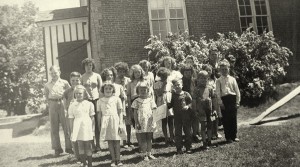
Class of 1947 : Irene Knisley is third from the right in the back row. Her older brother, Elgin Armstrong, is at the back left. Photo courtesy of Irene Knisley.
In 1960, Joan’s second year at Stanton, it combined with the Mansfield school, so the four younger grades went to Stanton and the four senior grades to Mansfield. Joan subsequently went to teachers’ college and university and taught most of her career in Toronto. Her final job was vice-principal of a city elementary school.
It’s not known if Barry Greer (another cousin) of London, Ontario, was the first Stanton graduate to go to university, but he was the first in the Greer connection. He finished grade 8 in 1958 and eventually became director-general of weather and water monitoring for all of Canada.
Far from being a detriment, Barry says, the rural school prepared him well for life and his career, especially in regard to management skills.
“You were used to being around people of all ages all the time in school, so it created that environment where you weren’t intimidated by the older kids because you sat beside them in class all day and played with them, and you were also used to interacting with people younger than you.
“Also, there was always something going on in the room – oral classes to other grades or kids reading out loud or doing lessons on the blackboard – so if you had work to do, you had to learn to focus, to concentrate no matter what was going on around you.”
···
After the Knisleys purchased the school, they did some remodelling to make the building habitable as a summer home – running water and indoor plumbing to start with. But when Bill retired in 1988, they began more extensive plans for their 1,500-square-foot retirement home. Most of the work was done in 1991 and they moved in full time that fall.
There is no basement in the building and the foundation was fine, Bill says. But a lot of brick work was required (the original structure had three-brick-thick walls). The old front porch and east-facing steps were demolished and the entrance was moved to the west end of the new sun porch. They decided not to change the character of the building with other additions, but did build a detached garage.
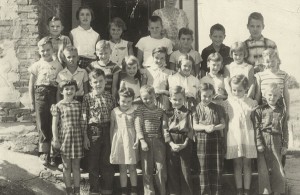
Class of 1958 : In the front row, third from the left, is writer Susan Greer. To her left are Paul Greer (a cousin) and Donald Greer (not related), who comprised the entire grade 1 class. The teacher, partially cut out of the original photo, is Winnifred Bates. Photo courtesy of Susan Greer.
Inside, they took down the wall between the cloakroom and the main schoolroom. Where many of the pupils and the old woodstove sat is now an open-concept kitchen, dining area and living room, with one new wall separating the kitchen from one end of the living room. Several feet in front of where the blackboards and teacher’s desk would have been, Knisleys added a wall with a fireplace. Behind that is a small bedroom, across a short hall from a bathroom.
Where you enter “the back part,” there is a slight slope in the floor because the second classroom was built one step lower than the original school. The generous height of the roof allowed Knisleys to create a partial second storey, with stairs leading to a loft, used as a den, and a large bedroom, both lit with sky-lights. On the main level of the back part are the master bedroom, another bathroom, utility room and closets. The house is now heated with a combination of propane and electricity.
It is in the main living area where the building’s past is most evident. Underfoot in the kitchen and dining area is the school’s original hardwood floor. Above the dining-room table is one of the school’s light fixtures. Irene’s china cabinet used to be the school’s library cupboard, although it has been cut down from nine to seven feet to accommodate lowered ceilings. Three slate plaques on the wall were created by a local artist from the school’s blackboards.
Now that the days of walking a mile to and from school, winter and summer, up and down some of Mulmur’s steepest hills, are just a memory, Irene is happy with their decision to purchase the school and proud of her family’s long ties to it.
Outside, the ditch in front of the schoolyard overflows each summer with wild orange day lilies, just as it always did, and when the September wind blows just right, the joyful sounds of the hundreds of children who learned and played at SS#1 still seem to echo faintly up the hill.

